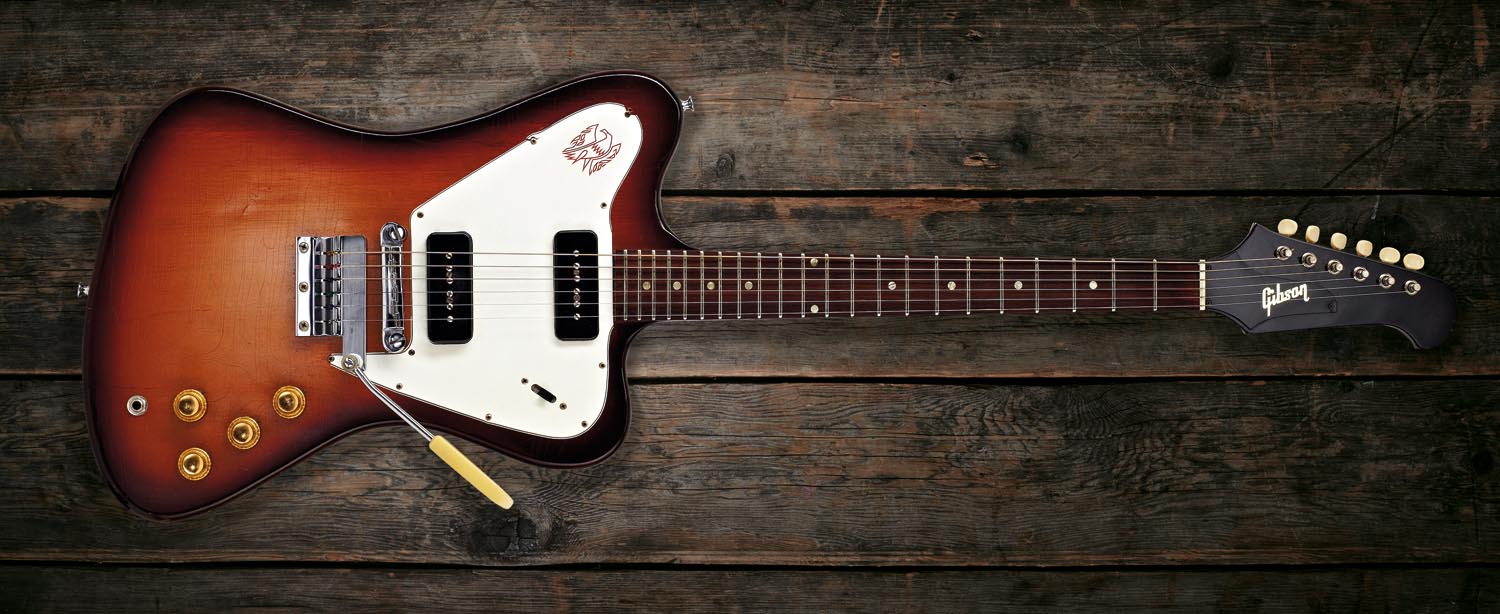Everything you need to know about Gibson Non-Reverse Firebirds
The 'bird that never quite flew was a radical new angle for '60s Gibson design

Gibson Firebirds first appeared in 1963 in the form of four models: the single-pickup/dot-inlay I; dual-pickup/dot-inlay III; dual-pickup/trapezoid-inlay V; and triplepickup/block-inlay VII.
With their angular geometry and custom colours, the original line-up of Explorer-like ‘reverse’ Firebirds was intended to tap into the zeitgeist of the forward-thinking, automobile-obsessed younger generation and compete directly with Fender in the popular solidbody market.
Unfortunately, the Firebird did not rise like the proverbial phoenix as hoped. Despite its flashy looks, it failed to catch on, and shipping figures show the early reverse Firebirds had only a fraction of the SG range’s success during their brief existence from ’63 to ’65.
To add insult to injury, the Firebird’s design was hotly contested by Fender as a mirror image of its patented offset Jazzmaster and Jaguar body shapes. Furthermore, its construction made them tricky to build, transport and handle.
In a recent interview, Mat Koehler, Gibson’s head of product development, told us: “In ’63, after the first [Firebirds] were made, [Gibson president Ted McCarty] was probably thinking, ‘What did I get myself into here?!’ It was a difficult build – and still is for us now.” Alas, in June 1965, a new breed of Firebirds was unveiled at the NAMM show – the non-reverse models.
Although Gibson retained the same model names, these guitars were a world apart from their reverse-style counterparts…
- Looking for Reverse Firebirds? Here's everything you need to know
Gibson Firebird I
The reverse Firebird I features a single bespoke-designed Firebird mini-humbucker pickup adjacent to the bridge and two knobs, whereas the non-reverse Firebird I is endowed with a pair of black ‘soapbar’ P-90 single-coil pickups controlled by a black sliding selector switch and four knobs (volume and tone for each pickup).
All the latest guitar news, interviews, lessons, reviews, deals and more, direct to your inbox!
Unlike the reverse Firebird I, the nonreverse model came with a Gibson Vibrola tailpiece as standard. Priced at $189.50, upon its release it was the least expensive instrument in the line-up.
As per the reverse Firebird range, Sunburst was the standard finish across all non-reverse models. In addition, Gibson continued to provide customers and dealers with a range of 10 Fender-style custom colour options.
These included Frost Blue, Ember Red, Cardinal Red, Kerry Green and Polaris White, as well as metallic (‘Poly’) shades called Golden Mist, Silver Mist, Pelham Blue, Heather and Inverness Green.
Gibson Firebird III
Aside from body shape, the non-reverse Firebird III can be distinguished from its dual mini-humbucker reverse-style predecessor by its configuration of three single-coil pickups.
Like the non-reverse Firebird I, this version of the Firebird III came with a Gibson Vibrola as standard. $239.50 upon release, the Firebird III offered “all the range and versatility you could ask for, plus sharpness in the treble range and depth in the bass”, thanks to its ES-5/Switchmaster-style triple P-90 configuration.
The reverse ’Birds had a neck-through-body construction that was difficult and expensive for Gibson to make, and their heavy banjo tuners exacerbated the issue of headstock fractures.
In the wake of Fender’s CBS takeover in ’65, Gibson made its move and unveiled these more Jazzmaster/Jaguar-like non-reverse designs. With a flat body, unbevelled headstock with regular bass-side right-angled tuners and a glued-in neck they were less costly to produce and, therefore, ultimately cheaper to buy.
Gibson Firebird V
While the reverse Firebird V features a single-bound rosewood fretboard with trapezoid inlays, the non-reverse version was scaled back with an unbound rosewood ’board and dot inlays (as featured on all non-reverse Firebirds) and its price was reduced in ’65 from $360 to $289.50.
It did, however, retain its ‘leaf-and-lyre’-engraved Deluxe Vibrola tailpiece, Tune-o-matic bridge and dual mini-humbuckers. The Firebird mini-humbuckers feature a solid metal cover.
As opposed to other PAF-derived Epiphone/Gibson mini humbuckers with a single Alnico bar magnet below passive slugs and adjustable pole pieces/screws, the Firebird pickup’s design has a pair of blade magnet coils and inductanceenhancing ferrous reflector plates above and below both coils.
With a narrower coil aperture and fewer coil windings, the midrange-focused tone is often described as somewhere between a Fender single coil and regular Gibson humbucker.
Gibson Firebird VII
With its gold-plated hardware – including a ‘leaf-and-lyre’-engraved Deluxe Vibrola, Tune-o-matic bridge, tuners and pickup covers – and triple mini-humbucker configuration, the Firebird VII remained at the top of the pecking order priced at $379.50 (a reduction in price from the $500 ’65 reverse Firebird VII with its bound ebony fretboard and large block inlays).
“Here is the ultimate in a solidbody guitar,” reads the Gibson catalogue. “A completely new and exciting instrument that offers all the sound, response, fast action and wide range that could be desired.”
Unfortunately, the guitar-buying public did not wholeheartedly agree.
After Firebird sales reached their peak in ’66 with around 2,500 guitars shipped (not including around 250 V-12 electric 12-string Firebirds) sales plummeted to around 750 in ’67, and again to only around 275 in ’68. By 1970, the range was discontinued with less than 100 Firebirds shipped in ’69.
Rod Brakes is a music journalist with an expertise in guitars. Having spent many years at the coalface as a guitar dealer and tech, Rod's more recent work as a writer covering artists, industry pros and gear includes contributions for leading publications and websites such as Guitarist, Total Guitar, Guitar World, Guitar Player and MusicRadar in addition to specialist music books, blogs and social media. He is also a lifelong musician.





